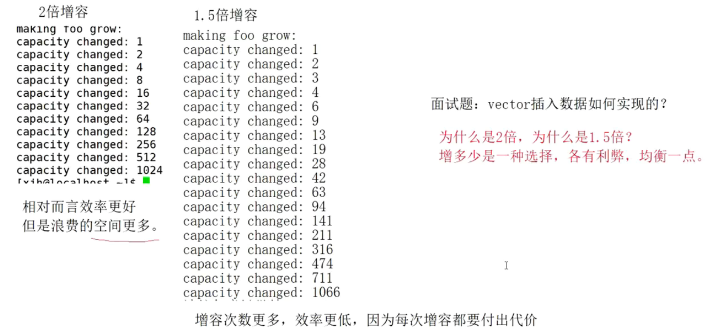【C++】 Vector容器操作全解析
C++ Vector 容器详解
1. 容量与大小管理
1.1 基本容量操作
-
size():返回当前元素个数 -
capacity():返回当前分配的内存容量(可容纳的元素数) -
empty():判断容器是否为空
1.2 容量调整操作
-
resize(n):改变 size-
若 n > size,新增元素默认初始化(对于基本类型为0,类类型调用默认构造函数)
-
若 n < size,删除尾部多余元素
-
可选第二参数指定初始化值:
resize(n, value)
-
-
reserve(n):改变 capacity-
只开空间,不初始化,不影响 size
-
如果 n < capacity,通常无效果(实现可能忽略)
-
如果 n > capacity,重新分配内存,可能导致迭代器失效
-
2. Vector 的扩容机制
2.1 不同编译器的增长策略
-
VS (PJ STL):1.5 倍增长
-
g++ (SGI STL):2 倍增长
-
Clang (通常):2 倍增长
2.2 扩容性能分析
-
摊销常数时间:虽然单次扩容可能耗时,但多次操作的均摊时间复杂度为 O(1)
-
扩容代价:需要分配新内存、拷贝元素、释放旧内存
-
reserve 只负责开辟空间,如果确定知道需要用多少空间,reserve 可以缓解 vector 增容的代价缺陷问题。
-
resize 在开空间的同时还会进行初始化,影响 size。
// 测试vector的默认扩容机制 void TestVectorExpand() { size_t sz; vector v; sz = v.capacity(); cout << \"making v grow:\\n\"; for (int i = 0; i < 100; ++i) { v.push_back(i); if (sz != v.capacity()) { sz = v.capacity(); cout << \"capacity changed: \" << sz << \'\\n\'; } } }
// 如果已经确定vector中要存储元素大概个数,可以提前将空间设置足够 // 就可以避免边插入边扩容导致效率低下的问题了 void TestVectorExpandOP() { vector v; size_t sz = v.capacity(); v.reserve(100); // 提前将容量设置好,可以避免一遍插入一遍扩容 cout << \"making bar grow:\\n\"; for (int i = 0; i < 100; ++i) { v.push_back(i); if (sz != v.capacity()) { sz = v.capacity(); cout << \"capacity changed: \" << sz << \'\\n\'; } } }1.2.4vector 增删查改
push_back(val):尾部插入(拷贝或移动)
pop_back():尾部删除(不返回被删除元素)
emplace_back(args...)(C++11):直接在尾部构造元素,避免拷贝
emplace(pos, args...)(C++11):在指定位置直接构造元素
find 查找(注意这个是算法模块实现,不是 vector 的成员接口)
insert 在 position 之前插入 val
erase 删除 position 位置的数据
swap 交换两个 vector 的数据空间
operator[] (重点) 像数组一样访问
4.2 插入操作详解
vector v = {1, 3, 4};// 插入单个元素v.insert(v.begin() + 1, 2); // v = {1, 2, 3, 4}// 插入多个相同元素v.insert(v.end(), 3, 5); // v = {1, 2, 3, 4, 5, 5, 5}// 插入范围vector other = {6, 7, 8};v.insert(v.end(), other.begin(), other.end()); // v = {1, 2, 3, 4, 5, 5, 5, 6, 7, 8}// 使用初始化列表插入(C++11)v.insert(v.begin(), {0, -1}); // v = {-1, 0, 1, 2, 3, 4, 5, 5, 5, 6, 7, 8}4.3 删除操作详解
vector v = {1, 2, 3, 4, 5, 6, 7, 8, 9};// 删除单个元素v.erase(v.begin()); // 删除第一个元素// 删除范围v.erase(v.begin() + 2, v.begin() + 4); // 删除第3和第4个元素// 删除所有元素v.clear();// 删除满足条件的元素(使用erase-remove惯用法)vector v2 = {1, 2, 3, 4, 5, 6, 7, 8, 9};v2.erase(remove_if(v2.begin(), v2.end(), [](int x) { return x % 2 == 0; }), v2.end());// 删除所有偶数4.4 查找操作扩展
#include #include vector v = {1, 2, 3, 4, 5, 3, 2, 1};// 查找第一个匹配元素auto it = find(v.begin(), v.end(), 3);if (it != v.end()) { cout << \"Found at position: \" << distance(v.begin(), it) << endl;}// 查找最后一个匹配元素auto rit = find(v.rbegin(), v.rend(), 3);if (rit != v.rend()) { cout << \"Last found at position: \" << distance(v.begin(), rit.base()) - 1 < 3; });// 查找子序列vector sub = {3, 4};auto it3 = search(v.begin(), v.end(), sub.begin(), sub.end());Lambda 表达式
[capture](parameters) -> return_type { function_body }具体分解
-
[]: 捕获列表(空,表示不捕获任何外部变量) -
(int x): 参数列表(接受一个整数参数 x) -
{ return x > 3; }: 函数体(返回 x > 3 的比较结果)
Lambda 表达式的特性
-
匿名函数:没有函数名,直接定义和使用
-
类型推导:编译器自动推导返回类型(这里返回
bool) -
捕获能力:可以通过捕获列表访问外部变量(这里没有使用)
等价函数
这个 lambda 表达式等价于以下传统函数:
bool greater_than_three(int x) { return x > 3;}Lambda 表达式的更多用法
捕获外部变量
int threshold = 3;// 通过值捕获外部变量auto it = find_if(v.begin(), v.end(), [threshold](int x) { return x > threshold; });// 通过引用捕获外部变量auto it = find_if(v.begin(), v.end(), [&threshold](int x) { return x > threshold; });指定返回类型
// 显式指定返回类型auto it = find_if(v.begin(), v.end(), [](int x) -> bool { return x > 3; });复杂逻辑
// 多个条件的lambdaauto it = find_if(v.begin(), v.end(), [](int x) { return x > 3 && x % 2 == 0; // 大于3的偶数});4.5 访问操作扩展
vector v = {1, 2, 3, 4, 5};// 使用operator[](不检查边界)int a = v[2]; // a = 3// 使用at()(检查边界)try { int b = v.at(10); // 抛出std::out_of_range异常} catch (const out_of_range& e) { cout << \"Out of range: \" << e.what() << endl;}// 访问首尾元素int first = v.front(); // 等同于v[0]int last = v.back(); // 等同于v[v.size()-1]// 直接访问底层数据int* data = v.data(); // 获取指向底层数组的指针标准库算法 std::find 的返回值是迭代器:
C++ 标准库的算法(如 find、sort 等)是通用的,可以适配各种容器(vector、list、set 等)。
-
迭代器为不同容器提供了统一的访问接口:无论容器内部存储结构如何(数组、链表等),算法都能通过迭代器遍历和操作元素。
-
若不使用迭代器,
find函数需要为每种容器单独实现(如vector用索引,list用指针等),违背了代码复用的原则。


